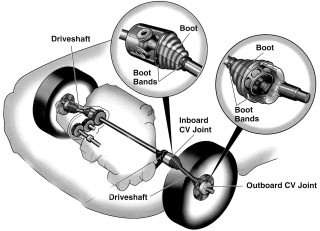On front and all-wheel drive cars, the axle shafts are what connect the transmission with the wheels, driving the vehicle along. The axles must flex, allowing the suspension to move up and down and the front wheels to turn right and left, while at the same time transmitting the driving force from the engine to the wheels.
The part that simultaneously enables the axle to flex while transmitting the driving force is called a drive axle joint, and is also known as a constant velocity (or CV) joint. The CV Boot is a ribbed, rubber flexible boot that keeps water and dirt out of the joint and the special grease inside the joint. Pictured here is a view of a front, outer CV boot that has torn open.
The greasy mass inside is the actual joint itself. If the car is driven in this condition, the exposed grease is quickly slung out by centrifugal force as the axle rotates, and the joint subsequently becomes contaminated with sand, dirt, rocks, and water, rapidly wearing the joint components. Excessive wear may necessitate replacement of the entire axle shaft assembly, a much more expensive proposition than replacing the boot itself.


